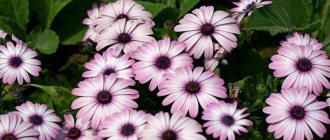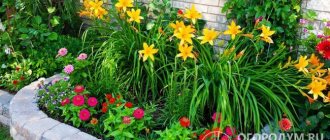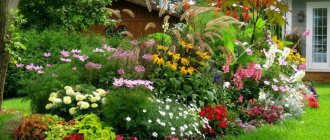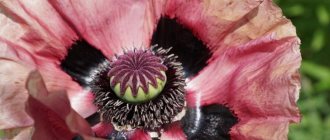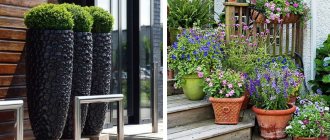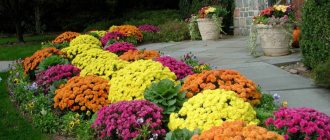It is not always possible to pay much attention to flower beds in the garden. Suddenly urgent matters appear and our flower beds do not receive the attention they deserve. If you want your flower beds to always look beautiful, pay attention to unpretentious perennial flowers for the garden. Many of them are long-flowering and do not require special care. Often they are not inferior in beauty and smell to the most exquisite species. I provide photos and names of such flowers in this article.
You can have a thriving garden without devoting too much time to it.
Photos and names of perennial unpretentious flowers that bloom all summer from May to September
Perennials are plants that do not need to be replanted every season. Their root system tolerates winter well and produces new growth in the spring. Perennials have a number of advantages, the main ones of which are:
- good winter hardiness;
- the ability to reproduce well;
- variety of species;
- long flowering period;
- ability to grow without transplantation for many years;
- low maintenance requirements.
Perennials, however, are more susceptible to root diseases than annual plants.
To create a flower bed that does not require special care, perennials are most suitable. Once you have completed all the plantings, you can enjoy a beautiful flower garden for several years. I recommend learning the basic rules for forming a flower bed from the article “What flowers to plant in a flower bed so that they match in color and height.”
To simplify the formation of a flower bed according to the color of perennials, you can turn to monochrome flower beds. In this case, you will get unusual stylish flower beds, and there will be no problems with an unsuccessful color combination.
Yellow
Flower beds made up of yellow flowers that bloom all summer lift your spirits and charge you with energy.
Perennials in yellow tones can be represented by:
- coreopsis;
Coreopsis. - rudbeckia;
Rudbeckia. - St. John's wort;
St. John's wort. - heliopsis;
Heliopsis. - astilbe;
Astilbe. - daylily;
Day-lily. - ordinary cuff;
The cuff is ordinary. - loosestrife
Loosestrife.
Flower beds in yellow tones are distinguished by the brightness of their colors. People who choose yellow are optimistic and radiate vitality. It is easy and pleasant to communicate with them.
Blue
The color blue symbolizes dreaminess and hope. Blue flower beds evoke pleasant thoughts, calm, and put you in a lyrical mood. In a blue flower garden you can plant:
- lavender;
Lavender. - blue chamomile;
Blue chamomile. - cornflower;
Cornflower. - phlox;
Phloxes. - delphinium;
Delphinium. - lupine;
Lupine. - periwinkle;
Periwinkle. - loosestrife;
Loosestrife. - oak sage.
Oak sage.
Blue flower beds are chosen by dreamers and romantics.
Tulip
Well-known and beloved tulips have so many shapes, varieties and varieties that even the most capricious gardener will choose a flower to suit his taste - including the flowering period.
In May, you will be able to delight with the bright colors of simple and double early tulips, Triumph tulips, Darwin hybrids, lily-flowered tulips, Rembrandt tulips, some fringed and green-colored ones... And if you don’t know how they differ from each other, our detailed material is for you to help.
- 15 main types of tulips - do you have everything (photos, descriptions, varieties)
All classes of tulips in one article
Low-growing outdoor flowers for flower beds that do not require special care
Flowers not exceeding 30 cm in height are considered undersized. These “babies” are irreplaceable at the edge of a flower bed or along a path. They make good borders. Low plants are also placed on a stone hill.
Gypsophila
Light and airy gypsophila lace adds elegance to any flower bed. The gypsophila bush is not tall, but lush. Small flowers of white, purple and lavender colors cover the entire bush.
Gypsophila.
Gypsophila perfectly complements larger flower specimens, but can be planted separately. Gypsophila sprigs often complement bouquets, or form a bouquet for the bride.
Muscari
In early spring, small muscari bushes are pleasing to the eye. Their blue, blue or white flowers are unusually charming: dense pyramids resemble mushrooms more than flowers. This plant is naturally distributed in the mountains of Europe and Asia Minor.
Muscari.
Muscari flowering lasts 3–4 weeks. This flower is the most valuable because it appears very early, before tulips and daffodils.
Crocuses
The earliest flowers include crocuses and saffron. Delicate, pubescent inflorescences of blue or white flowers appear immediately after the snow melts. The height of the plant does not exceed 15 cm.
Crocuses.
Landscape designers love to use crocuses in rock gardens or rock gardens. Plants can be transplanted during the period when their growth is fading, that is, in August or September.
Periwinkle
A dense carpet of delicate small blue flowers can charm even the most unsentimental people. Such a carpet is woven by periwinkle. Not only the flowers are amazing, but also the leaves. They are shiny, glossy, dark green in color. It looks like the periwinkle leaves are artificial.
Periwinkle.
This flower grows in Europe and Southeast Asia. Periwinkle blooms in spring and grows quickly. This is an excellent ground cover plant.
Pushkinia
Delicate Pushkinia flowers perfectly complement the spring flower garden. In nature, this plant can be seen in the Caucasus and Iran. Pushkinia prefers mountain landscapes.
Pushkinia.
Pushkinia blooms in April or May and blooms for 2–3 weeks. Its flowers are collected in inflorescences in the form of a brush. Many varieties of Pushkinia have a delicate, pleasant aroma. This plant is ideal for decorating rockeries and rock gardens.
Houseplants from seeds
Cyclamen persica
One of the best plants for winter flowering.
Persian cyclamen Pink with an eye - height 20-25 cm. Leaves are dark green in color with white ornaments. Forms many flower stalks with graceful fragrant flowers up to 5 cm long. Color: pink with an eye. Resistant to pests and diseases. Flowering - November-March.
Cyclamen Persian mini Red - height 15-20 cm. Decorative dark green foliage with a white pattern. Forms many flower stalks with graceful fragrant flowers. Color: red. Resistant to pests and diseases. Flowering - November-March.
Medium height
Flowers about 50 cm high are considered medium-sized and are intended for the middle tier of a flower bed or mixborder. This group includes most unpretentious plants for the garden. This is the main material for gardeners to create landscape design.
Tulips
Most gardeners show a reverent attitude towards tulips, because they are one of the first to appear and have an endless variety of shapes and colors. These are bulbous plants of the lily family.
Tulips.
Tulips can be very small - about 10 cm in height, and tall - up to 90 cm. Flowers can be simple or double, with wavy or terry edges. There is often one large flower on one stem, but there can be several. The colors of the flowers are very diverse, including black and green. Flowering begins in late April - early May and lasts 20 days.
Varietal tulips are dug up after flowering and stored in a dark, cool place until August. In August, the bulbs are planted again in the flower beds. You don’t have to dig up the tulips, but then the flowers won’t be as large.
Dicentra
The unusually shaped fruits make dicentra a mysterious plant that attracts attention. Its flowers are heart-shaped and pale pink or white. Dicentra can be called a romantic flower. It came to us from North America, as well as China and the Far East.
Dicentra.
The height of the dicentra bush ranges from 30 to 60 cm. In one place, the plant can grow well and develop for up to 8 years. The plant blooms in May and looks good in a flowerbed next to other spring flowers: tulips, hazel grouse, daffodils.
Geranium
This flower is an exception because it cannot overwinter on the site. For the winter it is placed in a room on the windowsill. But geranium flowers are so good that such troubles are completely justified.
Geranium.
Geranium or pelargonium flowers are collected in inflorescences, have a variety of colors and are not inferior in beauty to roses. The varieties with double flowers look even more beautiful. Geraniums continue to bloom all summer.
Day-lily
The daylily acts as a kind of lifesaver in the garden. This flower is absolutely universal: it looks great both in individual plantings and in a flower bed. Daylily perfectly camouflages unsightly buildings and enlivens boring fences, forming spreading bushes with beautiful leaves and bright yellow or orange flowers. Flowers resembling lily flowers can sometimes have an unusual speckled color.
Day-lily.
Europe and Asia are considered the homeland of the daylily. This plant has dwarf varieties, the height of which does not exceed 30 cm, and can grow more than a meter. In one place, daylily feels great for up to 15 years.
Duchesnay
This unusual plant is often confused with... strawberries. It really resembles it both in leaves and “fruits”. This is what people call it: “false strawberry.”
The flowering period is short, the flowers themselves are yellow and inconspicuous, but they look beautiful against the background of a green carpet. By the way, this carpet does not lose its attractiveness all summer long; it spreads across the dacha area, but does not weave everything in a row. The berries that form after flowering are not poisonous, but tasteless, so throughout the summer season they serve only a decorative function. Duchesnea looks “like a cucumber” in the sun, even with extremely rare watering. So this is a great option for those who rarely visit their country house.
Photo: Instagram maman.vs
Photo: Instagram photo_trip_sochi
Photo: Instagram filifionka_annet
- Landscape
How to make a flowerbed that does not require complex care: 5 practical tips
Tall and large long-blooming flowers for the garden
Tall specimens are indispensable in the garden. They can act as:
- tapeworm plants in the background of the site;
- central plants in the flowerbed;
- framing an arch or gazebo;
- hedges;
- camouflage for unsightly buildings.
Astilbe
All gardeners love the wonderful astilbe flowers. They appear to be made of soft material and resemble plush toys. This is a plant of the Saxifraga family. It has many varieties. It came to us from North America and East Asia.
Astilbe.
Astilbe is good because it feels great not only in the sun, but also in shaded areas. Abundant flowering of the plant can be observed from the beginning of June to the end of August: different varieties have their own flowering periods.
Astilbe is a plant that can be planted as a border: some of its varieties are very small in size (about 30 cm), or can be used as a central plant in a flower bed. High varieties of astilbe reach one and a half meters in height.
Astilbe loves water and does not tolerate drought. The plant propagates by dividing the bush or by seeds.
The unusual shape of astilbe flowers makes it attractive in any flower bed. It goes well with most plants.
Delphinium
Solemn huge candles-inflorescences of delphinium look good against the boring background of a fence or barn wall. The flowers reach two meters in height and come in many shades of blue, as well as white specimens. You can admire the blooms all summer long if you choose the right varieties. Each variety blooms for about a month. But if you cut off wilted flowers, flowering may occur again in about a month.
Delphinium.
Delphinium also has dwarf varieties that barely reach 30 cm. But in most cases, gardeners prefer to grow giants. If you plant tall varieties of delphinium often enough, they can become a flowering hedge.
Delphinium is propagated by dividing the bush and seeds. It prefers sunny areas with light shade.
The disadvantages of delphinium include its toxicity. It poses a danger to pets and small children. Therefore, they try to plant it on the far edge of the site.
Stockrose
The charming holly has established itself as a “country flower”. Indeed, if you want to decorate your garden in a “country” style, you won’t find more suitable flowers!
Stockrose belongs to the mallow family and came to us from North America. This plant reaches two meters in height and can be used as a flowering hedge or as a camouflage for fences. These giants have large flowers of a wide variety of colors, simple or double. Stockrose blooms in the second year after planting. Because numerous flowers are arranged on a stem, some fade while others bloom. It turns out that the stockrose blooms all summer.
With the help of hollyhocks you can decorate your garden in country style.
Irises
Northern orchids, as irises are called, thrive in central Russia and in more northern regions. When irises bloom, especially in a large flower bed, it is mesmerizing and arouses admiration!
Irises.
Irises bloom in May - June, not for very long, about two weeks. But the beauty they bring completely compensates for their short flowering period. In addition, irises have very decorative pointed leaves that decorate the flowerbed all season.
Iris leaves work well to support "decaying" flowers such as peonies.
Irises can have a dwarf shape - about 30 cm, or they can have tall stems - up to one and a half meters. Plants grow quickly and require replanting every 5–7 years. If the flowers are not replanted, the flowers become smaller.
The color of irises is very diverse: yellow, purple, blue, light blue, salmon and combinations thereof.
Peonies
Royal peonies occupy the second place in beauty in the garden after roses. Lush bushes reach a height of up to two meters, but require support. Large flowers have a wide variety of colors - from white to dark burgundy. Peony grows well in one place for up to 20 years. Some varieties have a delicate aroma.
Peonies.
Peonies work well in monobeds, but also look great with other plants. They tolerate winter well.
How to arrange a flower bed
In order for a flower bed to continuously please the eye from early spring to late autumn, it is necessary to take into account several important points when arranging it. Let's look at these points next.
Location
When choosing flowers for a flower bed, take into account the light preferences of the selected varieties. This is an important point because some outdoor plants bloom well only in the sun, while others only bloom in the shade. Select plants that have the same light requirements. In addition to light, it is necessary to take into account the plant preferences for soil composition, humidity level, and other important requirements.
Number of colors
If you have little experience in landscaping, you should not try to plant many types of plants at once. At first, it is better to limit yourself to two or three of your favorite varieties, and then expand the plantings.
Features of care
If you do not live in your dacha permanently, you should not choose flowers that require careful regular care. For busy gardeners (which is the majority), it is better to choose unpretentious plants that will not take much time to care for.
Select species and varieties in such a way that their care is similar - one watering, fertilizing, etc. Such a rational, thoughtful approach will greatly facilitate cultivation.
Color combination
When choosing flowers for a flower bed, you must immediately imagine how the flower garden will look when the buds bloom. Flowers should look harmonious, and not like a random collection of tacky shades. If you have problems with taste or simply don’t have time, stop at single-color flowerbed options or, at most, two-color ones.
Flowering time
This is the most important point to consider. If you want a flowerbed, the decorativeness of which does not fade from spring to autumn, you should also choose appropriate plants - with early, middle and late flowering periods.
Decor
Learn to mix color textures to create an interesting, heterogeneous flower bed design. Along with low and ground cover plants, plant tall ones that grow vertically - such a flower bed will look much more interesting.
If the general background of the flowerbed is calm, it doesn’t hurt to add some “zest” in the form of an unusual shape and color of the plant. For example, among simple daisies or cornflowers, plant irises, lilies, and amaranths, which look extremely elegant.
So, we got acquainted with the most popular and spectacular flowers that allow you to maintain the decorative appearance of your flower bed throughout the summer. There are a lot of types and varieties - and in the article we have not covered all of them. By planting flowers from the lists above, you can make the flower bed bloom from early spring to late autumn - to the delight of yourself and those around you.
Climbing flowers in the country
Vertical gardening of a summer cottage rests entirely on climbing plants. To add height to the garden, it is supplemented with various supporting structures: arches, pergolas, gazebos. Climbing plants are allowed to climb along these structures. To make it easier for vines to climb the supports, a special mesh is used. Curly shoots cling to the mesh with tendrils or wrap their stems around it. Sometimes vines are simply tied to supports.
Flowering arches, pergolas and gazebos decorate the garden and make it more attractive. Climbing plants can disguise the wall of a barn or house, or decorate a monotonous fence. Creepers can be allowed to climb up a dried tree.
Climbing unpretentious perennials that can be planted in the country are:
- ivy;
- actinidia;
- hop;
- climbing knotweed;
- Baldzhuansky knotweed;
- girl's grapes
More demanding plants to care for are capricious plants such as climbing rose or wisteria. But if you want to have truly unpretentious specimens, then select them from the list above. These plants grow quickly and cover all the space given to them with dense foliage. With their help, you can completely cover the walls of your house with vines. Such landscaping not only gives a decorative effect, but also protects the walls from overheating in the summer.
The only problem with unpretentious, or more accurately, aggressive, climbing plants is their limited distribution. With uncontrolled growth, powerful aggressors such as hops or knotweed can “clog” the entire area. To limit their growth, it is necessary to fence off the spread of roots with a powerful barrier made of sheets of profiled iron or slate, digging them to a sufficient depth. For absolute safety, aggressor loaches should be planted in a separate container.
The girl's grapes quickly wrap around all the space provided to it. It looks very decorative.
For fitting into tires
You can make cute flower beds on a budget by placing them in car tires. They will look elegant if painted in bright colors. You can choose oil paint in a can or aerosol paint in car spray cans. A flowerbed made from a tire hanging on the wall of a house or on a tree looks interesting and unexpected.
Unpretentious, drought-resistant plants are planted in improvised flowerpots made from car tires. They should not be very large, and their flowering should be long. You can put in tires:
- carnations;
- daisies;
- chrysanthemums;
- decorative bows.
Access to tires must be free. This ensures easy plant care.
For the arch
An arch entwined with flowering vines can become a focal point for the entire garden.
Clematis
Clematis are not very fancy plants that can decorate any arched structure. The clematis vine is decorated with large, bright flowers for a long time. Clematis blooms in the spring, but re-blooming is possible throughout the season. Clematis flowers can come in a wide variety of shapes and colors.
Clematis.
Maiden grapes
Girlish grapes look very good on the arch. It grows quickly and looks decorative in the fall: the red foliage will become a bright spot, clearly visible from all corners of the garden.
Maiden's grapes.
Hop
Hops will grow beautifully around the arch throughout the season. In autumn, beautiful white cones will decorate the arch and attract attention. But you need to make sure that the hops do not spread throughout the entire area.
Hop.
Actinidia
Actinidia can also be an excellent decoration for an arch. Kiwi is the fruit of actinidia, which grows in hot climates. For northern latitudes, scientists have developed frost-resistant varieties of actinidia, the fruits of which are superior in taste to kiwi. These are actinidia kolomikta, Argut, Gerald, purple, polygamous and hybrid. The berries of these varieties are large and sweet with a variety of flavors: fig, banana, candy, strawberry.
Actinidia.
Actinidia kolomikta looks great in vertical gardening, especially on an arch. Its leaves have bright pink spots with white splashes, which gives the vine an elegant variegated appearance. During the season, actinidia kolomikta can grow one and a half meters.
Schisandra chinensis
Schisandra liana is not only decorative, but also healing. Schisandra berries contain biologically active substances and give strength. Its healing properties are compared to ginseng.
Schisandra chinensis.
In the spring, the lemongrass vine is covered with snow-white fragrant flowers, in the summer it is decorated with clusters of ripening berries, and in the fall the vine is especially beautiful: red berries turn red against the background of lemon-yellow foliage. The length of the vine can reach 15 m, but in dacha conditions it is usually cut at a height of 1.5-2 m.
For the fence
A fence decorated with climbing plants looks elegant, protects the area from prying eyes and purifies the air from street pollution. A climbing rose is suitable for decorating a fence, but it is not an unpretentious plant. Wisteria also requires careful care. Among the unpretentious plants suitable for the fence:
- girl's grapes;
- clematis;
- hop;
- honeysuckle honeysuckle;
- ivy.
Honeysuckle Honeysuckle
This plant is very decorative and grows quickly. If you choose several varieties of honeysuckle that bloom at different times, you can have a fence decorated with flowers throughout the season. When using a technique such as pruning, the honeysuckle vine may bloom again.
Honeysuckle honeysuckle.
Ivy
Ivy vines grow quickly and form a dense, dense green wall. You don’t need to care for this plant at all: it tolerates drought and develops well both in the sun and in the shade. Ivy vines reach 3 m in length.
Ivy.
Ivy leaves are usually dark green in color, but there are decorative varieties with red and yellow splashes and stripes. Ivy with white edging of leaves looks very elegant. Flowers that are yellow in color are not particularly decorative.
Ivy is often used to create hanging gardens and is indispensable when decorating an English-style garden.
Palisade screen
A stylized country-style fence can be installed on a site to separate one area of the garden from another or to enclose a secluded place to relax. To do this, you can use a palisade made of small logs decorated with flowers. This type of fencing looks attractive and fits completely into the surrounding landscape.
To arrange such a fence, you need to do the following:
- Dig a narrow trench and fill it with 10 cm thick concrete.
- Install the posts using a plumb line.
- Plant plants around the picket fence.
Since the palisade has gaps, the entire structure does not look massive.
Palisade screen.
Meadowsweet (meadowsweet)
Many gardeners know meadowsweet under the name “meadowsweet”. This plant has been used in gardening since the 18th century. And this is not surprising, because the plant is unpretentious in care, blooms for a long time and beautifully, and is used in folk medicine.
Meadowsweet will grow well only if you plant it in a damp place: on the shore of a pond or in a lowland. Otherwise, you will have to water the plant frequently, otherwise the leaves will wither and the buds will fall off. Otherwise, care is simple: weeding and loosening. After flowering, in the fall, the meadowsweet needs to be trimmed, leaving 5-10 cm. The perennial does not need shelter: it is able to survive almost any winter.
The height of meadowsweet depends on the species. The tallest ones include red meadowsweet Venusta (1.5-2.5 m), red meadowsweet (1-1.7 m), red Magnifica (up to 1.7 m) and one of the tallest species - Kamchatka meadowsweet (1.2- 3m).
Shade-loving flowers for the garden
There are many shaded places in the garden that you also want to decorate with flowers. This is not difficult to do, since many flowering plants prefer shade and do not do well in the sun.
Shady areas are places where there is only a few hours of sun per day or where plants receive diffuse light through tree foliage.
Shade-tolerant flowers are represented in the garden by the following types:
- lily of the valley;
- dicentra;
- anemone;
- primrose;
- astilbe;
- hydrangea;
- periwinkle.
Periwinkle thrives in the shade and grows into a beautiful dense carpet.
Powerful vines, such as Actinidia kolomikta, maiden grape, and Schisandra chinensis, also do well in the shade.
Hostas and heucheras also prefer to grow in the shade.
Variety of flower beds
Before planting flowers, you need to decide on the place where they will grow. Previously, old car tires were widely used as flower beds, and some summer residents used ordinary beds without unnecessary finishing items instead of flower beds.
Today it is fashionable to plant flowers in various flowerpots and unusual flower beds. The main condition is their correct location and compatibility with each other.
Perennials blooming in the sun
A flowerbed laid out in an open sunny area can become the calling card of a dacha. In the sun, flowers feel great and reveal their full beauty. The splendor of the riot of colors of the sunny flower bed will appeal to even the most inveterate skeptic.
Flowerbeds located in the sun especially need proper planting: tall varieties are planted in the center, and low varieties are planted at the edges. This way all plants will be illuminated as much as possible.
Lavender
Lavender bushes are a wonderful decoration for any garden. Its flowers, from delicate light purple to light blue, adorn the plant from May to July. At the end of summer, the period of re-blooming begins. In one place, lavender feels great for up to 10 years. The plant emits a pleasant, unique aroma.
Lavender.
Lavender looks good in a flower bed, and is also excellent as a frame for paths and gazebos. With its help, they decorate a prairie-style garden and rockery.
Peony thin-leaved
The thin-leaved peony, popularly called “Voronets”, is becoming increasingly fashionable in gardens. This species is even more unpretentious than the currently common milky peony. Peony thin-leaved has beautiful lacy greenery and small, very bright red flowers. It blooms in mid-May in the gardens of the Moscow region for two to three weeks. Emits a subtle pleasant aroma.
Peony thin-leaved.
The height of thin-leaved peony bushes reaches only 40–45 cm. After flowering, the openwork foliage looks very decorative. Peony looks good in a flower bed, especially next to yellow spring flowers. Terry varieties look the most impressive.
The thin-leaved peony reproduces the landscape of wild nature and is widely used in creating large rock gardens, in combination with cereals, perennial flax, saxifrage and wormwood.
Purslane
Purslane looks great both in a flowerbed and in individual plantings. It can beautifully frame paths and flower beds, decorate rock gardens and alpine slides. Unusual leaves and large bright flowers make purslane unlike other perennial flowers. The colorful mats of this plant look very cute.
Purslane.
Purslane flowers are colored white, red, yellow, orange, lilac, and purple. Terry varieties are especially valued. Purslane blooms continuously from June to August and can be spread by self-sowing seeds.
Chamomile
This plant symbolizes purity and innocence. Chamomile is loved by gardeners for its unpretentious beauty and compatibility with almost any plant.
Blue chamomile.
Chamomile blooms from June to September. Dwarf varieties look great as border plants.
Snapdragon
This annual is popular due to its rich colors and delicate aroma. It blooms all summer and part of autumn - until the onset of frost. The variety of species (there are dwarf, low-growing, medium-growing, tall varieties) allows you to play with the design of flower beds and plant these plants in various corners of the garden. In its classic form, known for over 500 years, snapdragon is an erect plant. But breeders also developed hanging ones with long shoots - for window boxes or hanging baskets.
Photo: Instagram workshop_pattern_of_taatta_
Photo: Instagram larissa53
Photo: Instagram altair2015astrackan
- Landscape
10 signs of a would-be gardener who will ruin his entire harvest (check yourself)
Drought-resistant perennial flowers
Drought-resistant flowers do not require watering at all or for a long time. Such flowers can be grown without fear that they will dry out if there is no moisture for a long time. They cannot be called super beautiful, but they are quite decorative and brighten up the garden. Drought-resistant plants can be considered:
- lavender;
- yarrow;
- snowhead;
- rudbeckia shiny;
- Carpathian bells;
- sedum;
- young;
- mountain cornflower;
- phlox subulate;
- cloves
Matthiola bicornuum
She looks modest, and only blooms in the evenings. But it is loved for its strong sweet aroma and durability in spartan conditions. This is the case when you can sow a plant, forget about it, and find it a couple of months later by smell.
Seeds SEARCH Matthiola bicorna Lilac-pink
However, the plainness of flowers does not prevent gardeners from creating delicate, minimalist compositions, for example, in combination with stones.
Photo: Instagram zeleno.tyt
Photo: Instagram __tanya__ivanova__
Photo: Instagram zhiznakamnyah
Photo: Instagram olyamitskevich
- Landscape
10 beautiful flowers that will bloom in your garden even without care
Ground cover perennial long-blooming flowers
Ground cover plants can be seen in any garden. They hide the imperfections of the flowerbed, act as a contrast for tall plants, and cover empty areas with a thick multi-colored carpet. The soil, covered with a carpet of groundcover perennials, remains moist and does not dry out. Weeds cannot break through the dense carpet of plants. In addition to all these advantages, ground cover plants are unpretentious. That's why flower growers love them.
Unpretentious ground cover plants that bloom for a long time include:
- coin loosestrife;
- creeping thyme;
- phlox subulate;
- bryozoan;
- periwinkle;
- herbal cloves;
- capitate knotweed “Amethyst crumb”;
- peg;
- Aubrietta.
Anemone (anemone)
Anemone is a delicate and very fragile-looking, but very winter-hardy flower that can withstand the vagaries of the weather. Depending on the variety, the color of anemone flowers and their shape may vary - you can plant white, red, blue, purple, yellow forms on your site.
In the wild, anemones grow in shady forest lawns, in damp mountain valleys and even in alpine meadows. As an unpretentious spring perennial in your garden, you can plant oak, crown, tender, buttercup, and forest anemone. Their creeping rhizomes grow quickly, and large calyx flowers (or “daisies”, depending on the species) of a round-oval shape, if you select the varieties successfully, will delight you with long-term flowering.
If you want May flowering, look for spring-flowering forms of anemone, otherwise you will have to wait for bright colors until autumn.
What unpretentious perennials can be planted with seeds in the ground?
If you don’t have the time or desire to grow perennial flowers through seedlings, you can sow the seeds directly into the ground in the spring. As a result, you will get ornamental plants that will bloom, perhaps as early as next year.
You can sow seeds when the earth warms up enough: in April - May. Seeds are scattered in random order at the site of the future flower bed or in accordance with a specific pattern. After the seeds germinate, the plantings are thinned out, leaving only the strongest shoots and maintaining a distance between plants of about 30–40 cm.
Purslane
And this plant lives without shade or watering in the heat for as long as desired. Even the popular name “midday heat” speaks about this remarkable quality. Small bright flowers open their petals at ten o'clock in the morning and close at dusk. It spreads beautifully like a carpet over the lawn and is also suitable for hanging flowerpots.
Photo: Instagram my_own_paradise4142
Photo: Instagram guslica
Photo: Instagram _ania_b_
Photo: Instagram zarema_151008
- Landscape
9 garden plants that will make your 5 acres visually larger
What unpretentious long-flowering perennials grow in the regions of Russia?
The main problem for unpretentious perennial flowers is the cold winter, during which the roots of the plants may die. If you don’t want to bother yourself with covering your plants for the winter, then you should choose varieties that are suitable for frost resistance for your climate.
In Siberia
Many long-blooming, unpretentious perennial flowers grow well in Siberian gardens and tolerate cold winters well. In Siberia you can plant:
- crocuses;
- daffodils;
- tulips;
- muscari;
- irises;
- peonies;
- lilies;
- sedum;
- aquilegia;
- Highlander;
- phlox;
- chrysanthemums.
In the Urals
In addition to unpretentious, long-blooming perennial flowers that grow well in Siberia, they feel great in the Urals:
- phlox;
- periwinkle;
- cuff;
- clove grass;
- Turkish cloves;
- chamomile;
- day-lily;
- mountain cornflower;
- yarrow;
- astilbe;
- rudbeckia;
- echinacea;
- delphinium;
- rose stock;
- imperial hazel grouse.
In outskirts of Moscow
For the relatively warm climate of the Moscow region, you can select a large number of unpretentious and long-flowering perennials. In addition to the examples listed above for the Urals and Siberia, we can recommend:
- herbaceous peony;
- primrose;
- Phlox paniculata;
- garden bells;
- buzulnik;
- aster;
- decorative bows;
- thyme;
- tenacious;
- clean.
Pelargonium
Known since Soviet times as indoor geranium, but in recent years it has become widespread in landscape design. Blooms with bright umbrellas in the heat or partial shade. Close proximity to groundwater is undesirable so that the plant does not rot. It responds well to pinching shoots, loosening the soil and very dosed watering. Pelargonium is a perennial, but to be on the safe side for the winter, it is transplanted into a pot and taken from the street.
Photo: Instagram geranivkazani
Photo: Instagram home_gardens
Photo: Instagram elviracvety
- Landscape
10 flowers that will grow even where nothing grows
